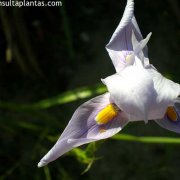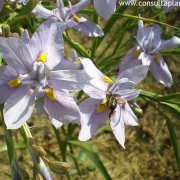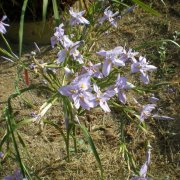Care of the bulbous plant Moraea polystachya or Cape blue tulip |
|
The genus Moraea, family Iridaceae, comprises 40 species of bulbous and tuberous plants native to Africa and Australia. Some species are: Moraea polystachya, Moraea ochroleuca, Moraea sulphurea, Moraea ciliata, Moraea pavonia, Moraea edulis, Moraea glaucopsis. Common names: Cape blue tulip, Butterfly Iris. This species is native to central South Africa and Namibia. This plant is extremely toxic to stock. They are easy to grow tuberous herbaceous plants that have long linear leaves that reach 80 cm (31.49") in length. The beautiful flowers are similar to Iris and can be blue, yellow, purple, white, etc. They bloom in summer. Cape blue tulip is used in rockeries, in borders, in groups with other bulbous plants and in pots. Moraea polystachya needs a sunny but protected exposure from the wind, next to a wall or a hedge, for example. If winter is cold, protect the bulbs with dry leaves or cover the pots with plastic. The soil can be a light substrate, with 1/3 of coarse sand and a little organic matter. Plant the bulbs in the fall. Water once a week slightly increasing watering during the flowering season. Fertilize at the time of planting with organic fertilizer and monthly with mineral fertilizer during spring. Moraea polystachya is sometimes attacked by thrips. Butterfly Iris propagates by division of bulbs in autumn. |
Images of the bulbous plant Moraea polystachya or Cape blue tulip |
Find plants
Moraea polystachya or Cape blue tulip | Care and Growing
© 2025 FavThemes


